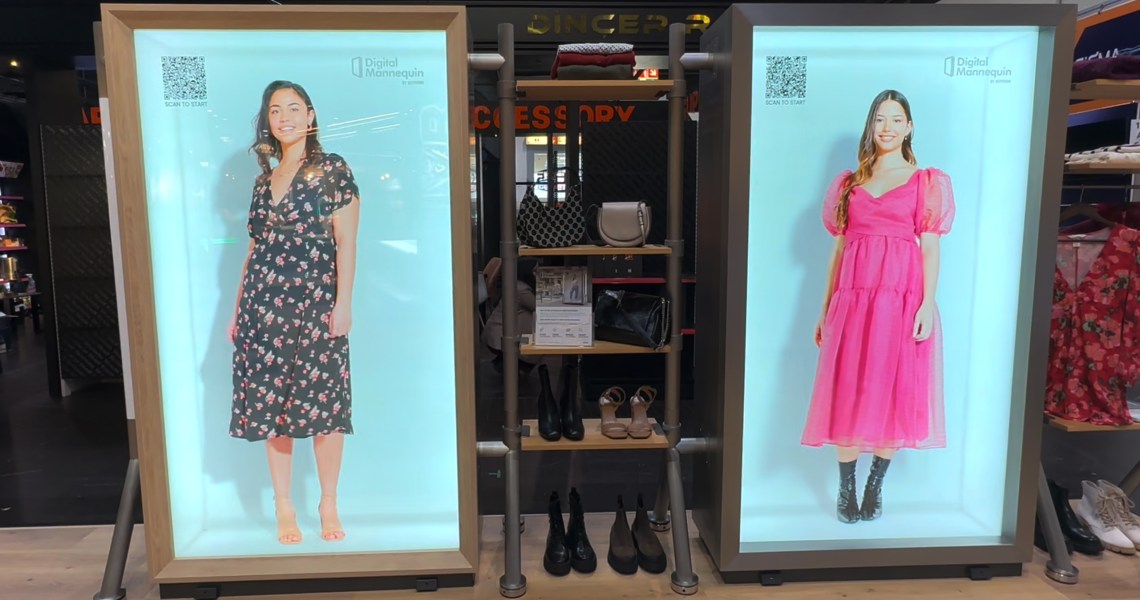Retail innovations including clothes with RFID tags, digital mannequins and seamless checkouts are removing the friction in the shopping experience — and exceeding Gen Z’s expectations.
Brands including Uniqlo, Zara and H&M are introducing in-store retail solutions that use these new technologies to facilitate product discovery, customer try-on and a seamless checkout experience.
According to May 2023 insights from a Klara study involving Gen-Z and millennials, 44% of Gen-Zers believe they will try on clothes in the same way in the future as today. Meanwhile, 40% said they expect to use virtual dressing rooms, 18% said they’ll use augmented reality, and 23% will rely on artificial intelligence to advise on which clothes best fit their body and fashion style.
Many brands are already changing their retail stores to integrate these technologies. In May 2022, H&M Group brand Cos piloted smart mirrors in its Beverly Hills store. Through the use of RFID tags, the mirrors allowed customers to order items to try on without leaving the changing room. RFID, or radio frequency identification, is a form of wireless technology that uses electromagnetic technology to track their location.
Web3 brands including 9dcc and RSTLSS, meanwhile, are equipping clothing with NFC, or “near-field communication,” tags. These tags bring capabilities to phygital items and facilitate updates on drops. NFC tags can also be used to create digital authenticity wallets or to show the composition or materials origin of garments and accessories in stores.
With labels and tags becoming digitized, they’re offering ways to make the retail experience faster and more seamless. Fast Retailing began to test RFID technology in its stores in 2013, and all of its brands — including Uniqlo, Theory and Helmut Lang — began using it in price tags in 2017. With them, items can be tracked for merchandising purposes. In 2019, Fast Retailing brought RFID-enabled self-checkouts to Uniqlo stores. The checkouts recognize the tags in the clothes and, without manually scanning, prices are calculated. All of its North American stores and new openings now have them.
“We developed self-checkout using RFID technology to help solve a pain point that all consumers have experienced: waiting in long lines,” said Masahiko Nakasuji, Fast Retailing Group global marketing executive officer. “We developed it from the perspective of the customer: What would make the checkout process easier for them?” So far, RFID self-checkout has reduced checkout times by 50%.
Ad position: web_incontent_pos1
Earlier this year, Zara’s owner, Inditex, announced that it is introducing a new security technology via chips sewn into garments, phasing out hard anti-theft tags in stores this year. The removal of anti-theft tags at checkout has become a pain point for the brand, with the process being slow and creating queues. According to Inditex, the new tags will cut checkout times by up to 50%.
In its renovated stores, H&M Group is also testing new retail innovations. The Barcelona H&M store, which reopened after a revamp in late May, uses technology to reduce friction in the store and bring people in. Hologram models offer customers a new way to visualize garments without trying them on. Customers access their choice of model by scanning a QR code and browsing through options of different sizes and skin tones. They can then choose clothing to try. The store also includes completely mirrored “social” fitting rooms, made to fuel user-generated social content.
The hologram digital mannequins and social fitting rooms were supplied by future retail agency Outform.
“In fashion, people increasingly want to see models that look like them, and now we offer that,” said Simon Hathaway, Outform’s group MD for EMEA. “Because all the tech is connected, potentially through to a retailer’s e-commerce site or app, the choice of items could be like an endless shelf.” While a digital mannequin is significantly more expensive than a traditional one, it typically becomes a hero item in store, functioning both as a display and a useful service.
Through digital mannequins and QR codes, brands can also gain insight into their customers’ behavior, both online and in-store. For example, hologram mannequins collect data on he items that customers interact with. “We call it a digital handshake, which is basically that moment in-store when you can connect somebody’s data point in the physical store with the wider unified commerce ecosystem,” said Hathaway. “That way, if somebody doesn’t buy the item, they can be re-targeted through social channels.”
Ad position: web_incontent_pos2
Augmented reality try-on has been tested by brands like Coach and Tommy Hilfiger, but many customers have provided feedback that the clothes need to be real, in order to see how they fall on the body. So far, Coach has mainly tested handbags and visual effects that don’t require this.
AR try on is also going further – Coach’s technology partner ZERO10 came out with a one stop AR store prototype next week, presented at the Viva Tech conference in Paris. The prototype, consisting of an iPad screen and AR mirror, is meant to reduce store rental costs as well as other expenses associated with commercial space rental, minimizing storage requirements, and avoiding overproduction.
“Rather than integrating it into existing stores, brands have the option to utilize the AR Mirror as a standalone pop-up store,” said founder of ZERO10 George Yashin. “This allows them to provide a fresh and unique experience for customers beyond their traditional point of sale locations and expand their presence to various venues such as festivals, airports, and public spaces, significantly saving on rental and space costs.”
According to the Klarna survey, 81% of Gen Z and 75% of millennials expect that AR will enhance their in-store shopping experience, and one-third believe this technology will eventually become standard across retail stores.




